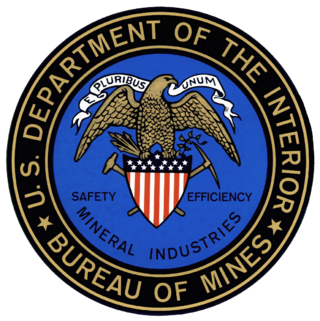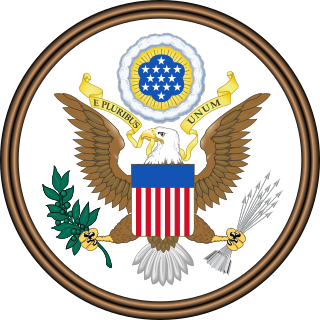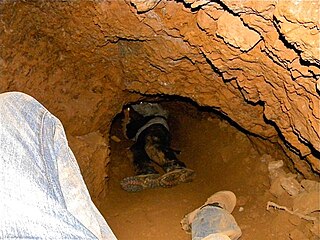Related Research Articles

Mining is the extraction of valuable geological materials and minerals from the Earth and other astronomical objects. Mining is required to obtain most materials that cannot be grown through agricultural processes, or feasibly created artificially in a laboratory or factory. Ores recovered by mining include metals, coal, oil shale, gemstones, limestone, chalk, dimension stone, rock salt, potash, gravel, and clay. The ore must be a rock or mineral that contains valuable constituent, can be extracted or mined and sold for profit. Mining in a wider sense includes extraction of any non-renewable resource such as petroleum, natural gas, or even water.

A safety data sheet (SDS), material safety data sheet (MSDS), or product safety data sheet (PSDS) is a document that lists information relating to occupational safety and health for the use of various substances and products. SDSs are a widely used system for cataloguing information on chemicals, chemical compounds, and chemical mixtures. SDS information may include instructions for the safe use and potential hazards associated with a particular material or product, along with spill-handling procedures. The older MSDS formats could vary from source to source within a country depending on national requirements; however, the newer SDS format is internationally standardized.

Mining in the engineering discipline is the extraction of minerals from underneath, open pit, above, or on the ground. Mining engineering is associated with many other disciplines, such as mineral processing, exploration, excavation, geology, and metallurgy, geotechnical engineering and surveying. A mining engineer may manage any phase of mining operations, from exploration and discovery of the mineral resources, through feasibility study, mine design, development of plans, production and operations to mine closure.

The National Institute for Occupational Safety and Health is the United States federal agency responsible for conducting research and making recommendations for the prevention of work-related injury and illness. NIOSH is part of the Centers for Disease Control and Prevention (CDC) within the U.S. Department of Health and Human Services. Despite its name, it is not part of either the National Institutes of Health nor OSHA. Its current director is John Howard.
The mineral asbestos is subject to a wide range of laws and regulations that relate to its production and use, including mining, manufacturing, use and disposal. Injuries attributed to asbestos have resulted in both workers' compensation claims and injury litigation. Health problems attributed to asbestos include asbestosis, mesothelioma, lung cancer, and diffuse pleural thickening.

For most of the 20th century, the United States Bureau of Mines (USBM) was the primary United States government agency conducting scientific research and disseminating information on the extraction, processing, use, and conservation of mineral resources. The Bureau was abolished in 1996.

The Mine Safety and Health Administration (MSHA) is a large agency of the United States Department of Labor which administers the provisions of the Federal Mine Safety and Health Act of 1977 to enforce compliance with mandatory safety and health standards as a means to eliminate fatal accidents, to reduce the frequency and severity of nonfatal accidents, to minimize health hazards, and to promote improved safety and health conditions in the nation's mines. MSHA carries out the mandates of the Mine Act at all mining and mineral processing operations in the United States, regardless of size, number of employees, commodity mined, or method of extraction. David Zatezalo was sworn in as Assistant Secretary of Labor for Mine Safety and Health, and head of MSHA, on November 30, 2017. He served until January 20, 2021. Jeannette Galanais served as Acting Assistant Secretary by President Joe Biden on February 1, 2021 until Christopher Williamson took office on April 11, 2022.

TheFederal Mine Safety and Health Act of 1977 amended the Coal Mine Safety and Health Act of 1969. It can be found in the United States Code under Title 30, Mineral Lands and Mining, Chapter 22, Mine Safety and Health.

An abandoned mine refers to a former mining or quarrying operation that is no longer in use and has no responsible entity to finance the cost of remediation and/or restoration of the mine feature or site. Such mines are typically left unattended and may pose safety hazards or cause environmental damage without proper maintenance. The term incorporates all types of old mines, including underground shaft mines and drift mines, and surface mines, including quarries and placer mining. Typically, the cost of addressing the mine's hazards is borne by the public/taxpayers/the government.

Mining in South Africa was once the main driving force behind the history and development of Africa's most advanced and richest economy. Large-scale and profitable mining started with the discovery of a diamond on the banks of the Orange River in 1867 by Erasmus Jacobs and the subsequent discovery of the Kimberley pipes a few years later. Gold rushes to Pilgrim's Rest and Barberton were precursors to the biggest discovery of all, the Main Reef/Main Reef Leader on Gerhardus Oosthuizen's farm Langlaagte, Portion C, in 1886, the Witwatersrand Gold Rush and the subsequent rapid development of the gold field there, the biggest of them all.

Asbestos is a naturally occurring fibrous silicate mineral. There are six types, all of which are composed of long and thin fibrous crystals, each fibre being composed of many microscopic "fibrils" that can be released into the atmosphere by abrasion and other processes. Inhalation of asbestos fibres can lead to various dangerous lung conditions, including mesothelioma, asbestosis, and lung cancer. As a result of these health effects, asbestos is considered a serious health and safety hazard.
Mining in the United States has been active since the beginning of colonial times, but became a major industry in the 19th century with a number of new mineral discoveries causing a series of mining rushes. In 2015, the value of coal, metals, and industrial minerals mined in the United States was US $109.6 billion. 158,000 workers were directly employed by the mining industry.
Venmyn Deloitte is a wholly owned subsidiary of Deloitte. The company provides consulting services to the global minerals industry, bridging the disciplines of mining and finance, and emphasises Deloitte's commitment to the global mining industry. It is headquartered in Sandton, Johannesburg, South Africa.

An artisanal miner or small-scale miner (ASM) is a subsistence miner who is not officially employed by a mining company, but works independently, mining minerals using their own resources, usually by hand.

Mark Cutifani is an Australian businessman and chair of the energy transition metals board at Vale Base Metals. He is a non-executive director of Total S.A. Cutifani is the former chief executive of mining group, Anglo American plc where he also served as a member of the Board. He was formerly CEO of South African gold mining company AngloGold Ashanti. Cutifani is a fellow of the Royal Academy of Engineering, a board member of the Hydrogen Council., recipient of the AusIMM Institute Medal. and Mines and Money Lifetime Achievement Award winner.

Occupational safety and health (OSH) or occupational health and safety (OHS), also known simply as occupational health or occupational safety, is a multidisciplinary field concerned with the safety, health, and welfare of people at work. These terms also refer to the goals of this field, so their use in the sense of this article was originally an abbreviation of occupational safety and health program/department etc. OSH is related to the fields of occupational medicine and occupational hygiene.

The Southern African Underwater and Hyperbaric Medical Association (SAUHMA) is an organisation of voluntary members with a special interest in the subject of underwater and/or hyperbaric medicine, recognised by the Council of the South African Medical Association as a special interest group. The Association promotes the practice and facilitates the study of underwater and hyperbaric medicine. Membership includes members and associate members, and may include medical practitioners; registered nurses; registered paramedics; qualified hyperbaric chamber operators; diving instructors; dive operators, and any other person with a special interest underwater or hyperbaric medicine.
In South Africa the Department of Public Enterprises is the shareholder representative of the South African Government with oversight responsibility for state-owned enterprises in key sectors. Some companies are not directly controlled by the Department of Public Enterprises, but by various other departments. Further, not all state owned entities are registered as companies.
Diving regulations are the stipulations of the delegated legislation regarding the practice of underwater diving. They apply within the national territory and territorial waters of a country. In most cases they apply to occupational diving, but in a few cases also to recreational diving. There are exemptions for recreational diving in some cases where it is recognised as a self-regulated industry. Offshore diving is generally outside the scope of diving regulations, and tends to be self-regulated through voluntary membership of industry organisations.
Commercial divers as defined in the Diving Regulations to the Occupational Health and Safety Act 85 of 1993 are required to be registered with the Department of Employment and Labour. The Department of Employment and Labour has jurisdiction only within the national borders of South Africa, and therefore registered diving schools are required to operate within the borders of South Africa where the Diving Regulations apply. A registered diving school is required to comply with the Code of Practice for Commercial Diver Training, and the training standards published by the department for divers, supervisors and instructors respectively.
References
- ↑ "Mine Health and Safety Council (MHSC) - Overview". nationalgovernment.co.za. Retrieved 2023-12-05.
- ↑ "Mine Health and Safety Act: Mine Health and Safety Council and permanent committees, Mining Regulation Advisory Committee, Mining Occupational Health Advisory Committee and Safety in Mines Research Advisory Committee: Nominations invited | South African Government". www.gov.za. Retrieved 2023-12-05.
- ↑ ""Mine Health and Safety Act"". vula.uct.ac.za. Retrieved 2023-12-05.
- ↑ view.officeapps.live.com https://view.officeapps.live.com/op/view.aspx?src=https://static.pmg.org.za/160406mhsc.pptx&wdOrigin=BROWSELINK . Retrieved 2023-12-05.
{{cite web}}: Missing or empty|title=(help) - ↑ "CENTRAL ENERGY FUND SOC LTD (CEF)". issuu. Retrieved 2023-12-05.
- ↑ "Mine Health and Safety Overview| Department of Mineral Resource". www.dmr.gov.za. Retrieved 2023-12-05.